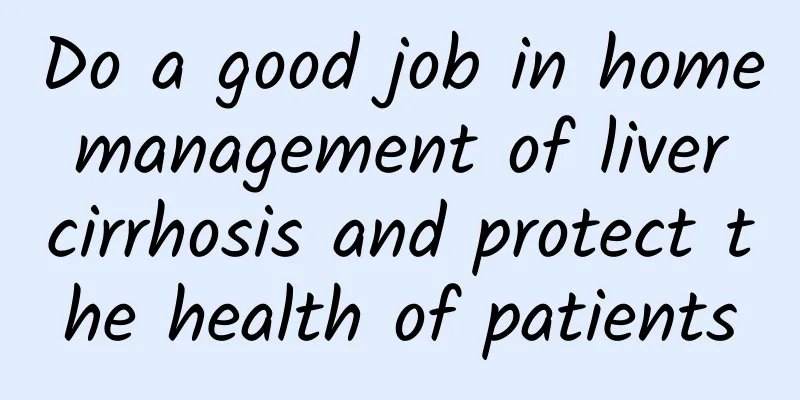Do a good job in home management of liver cirrhosis and protect the health of patients

|
Author: Yu Xiaoli, The Fifth Medical Center, PLA General Hospital Reviewer: Jin Bo, Chief Physician, Fifth Medical Center, PLA General Hospital Liver cirrhosis is a description of the fibrosis and hardening state of the liver after long-term chronic damage. It not only indicates severe damage to liver function, but also acts like a latent killer, silently threatening the patient's life and health. Therefore, for patients with liver cirrhosis and their families, good home management is like building a solid line of defense on the front line of the battlefield. 1. How can patients with cirrhosis manage themselves at home? 1. Regular diet: The diet should mainly consist of light, soft, easily digestible low-fat food. Avoid eating hard, rough, raw, cold, fried, spicy and irritating food and unclean food. Intake of protein should be reasonable. Try to eat more fresh vegetables and fruits; be sure to quit smoking and drinking. Figure 1 Copyright image, no permission to reprint 2. Combine work and rest: Do not engage in heavy physical labor, avoid fatigue, do simple housework, participate in social activities appropriately, keep a good mood, and avoid emotional fluctuations. 3. Take medicine on time: When taking special medicines, such as antiviral drugs, do not stop the medicine or change the dosage without permission to avoid aggravating the condition; before taking propranolol hydrochloride tablets, you should self-monitor your pulse in a resting state for 1 minute. If the pulse is ≤50 beats/min or you experience dizziness, low blood pressure and other discomfort symptoms, you should stop the medicine immediately and consult a doctor in time. 4. Self-observation of the condition: keep bowel movements smooth and observe the color, properties and amount of stool; observe whether abdominal distension or edema of both lower limbs worsens, whether appetite decreases, etc. 5. Check regularly. 2. How should you maintain good hand hygiene when coming into contact with patients with cirrhosis? Patients with cirrhosis have low immune function and weak resistance, and are prone to respiratory, digestive and urinary system infections. Especially patients with ascites may suffer from spontaneous bacterial peritonitis. There are more than 400,000 bacteria on each hand, so a pair of "dirty hands" can easily become a medium for cross-infection in hospitals. Therefore, hand washing is a simple, effective, convenient and important way to avoid cross-infection and protect patients. In order to cultivate a good habit of hand washing, many hospitals have placed hand-free disinfectants at the door of the ward for patients and their families to use. Patients at home should also always have soap, perfumed soap, hand sanitizer and other cleaning supplies. The seven-step hand washing method is shown in the figure below, and each step should be at least 20 seconds. Figure 2 Copyright image, no permission to reprint 3. How should patients with cirrhosis and their families observe their condition in daily life? 1. Patients with cirrhosis should maintain smooth bowel movements and develop a good habit of observing the nature and color of their stools, including black, tarry, bright red or dark red stools. 2. Patients with cirrhosis and ascites should take care to accurately record their daily urine and water intake, measure their body weight and abdominal circumference every day, and observe the disappearance of edema to determine the increase or decrease of ascites. 3. Observe for gastrointestinal symptoms such as abdominal pain, diarrhea, nausea, vomiting, or fever, and be alert to the occurrence of peritonitis. 4. Family members of patients with cirrhosis should pay attention to changes in the patient's consciousness, abnormal behavior, personality changes, and whether their memory, orientation, and calculation abilities have declined, so as to identify the early symptoms of hepatic encephalopathy in a timely manner. 5. Observe whether the patient has bleeding gums and nasal cavity, and whether there are bleeding spots on the skin. If the above symptoms occur, it indicates a decrease in platelet count and decreased coagulation function, and the patient should seek medical attention promptly. 6. Observe for any bleeding-related symptoms such as nausea, palpitations, burning sensation in the stomach, darkening of stool, bloody stool, etc. 7. Observe for symptoms related to electrolyte disorders such as limb weakness, oliguria, loss of appetite, blurred vision, and convulsions. 4. What are the dietary principles for patients with cirrhosis? The general dietary principle for patients with cirrhosis is to give them a soft, low-fat diet and avoid spicy foods. For patients with decompensated cirrhosis, a more individualized dietary treatment plan should be developed and implemented under the guidance of a specialist according to their condition. Figure 3 Copyright image, no permission to reprint 5. Why should patients with cirrhosis avoid eating dumplings, buns and other foods with residues or fillings? Figure 4 Copyright image, no permission to reprint The blood vessel walls of the stomach of patients with esophageal and gastric varices become thinner, like a blown-up balloon, which is easily scratched. Dumpling and bun skins are not easy to digest. Some bun and dumpling fillings contain crude fiber (such as leeks, green onions, celery) and foods with bones and thorns (such as small shrimps, crisp bones, and shrimp skins). Some patients chew less frequently and cannot digest the food completely, which mechanically scratches the varicose veins and causes venous rupture and bleeding. Therefore, patients with cirrhosis, especially those with esophageal and gastric varices, should avoid eating dumplings, buns and other foods with residues and fillings. 6. Why shouldn’t patients with cirrhosis eat too much pasta and sweets for dinner? The main ingredients of pasta and sweets are sugars, which can easily stimulate the secretion of gastric acid. At night, the vagus nerve of the human body is excited, which can speed up gastrointestinal motility, increase the secretion of digestive glands, increase the burden on the gastrointestinal tract, and digestive juices can easily erode the esophageal veins and gastric veins, thereby increasing the risk of bleeding. Therefore, dinner must be light and easy to digest, and don't eat too much. |
<<: Be careful! Genital Chlamydia trachomatis infection may "make a comeback"
>>: Iliotibial band syndrome: one of the main causes of knee pain
Recommend
What does Down syndrome screening test for? Do I need to fast?
Prenatal check-ups are not only an act of respons...
What to do if you have breast pain and fever during lactation
The only thing a mother can do during the confine...
Pain in inner thigh before menstruation
Pain in the inner thigh root before menstruation ...
Are there blood clots during menstruation?
Menstruation is a normal physiological function o...
What is the effect of adding white wine to pickled cucumbers? When should white wine be added to pickled cucumbers?
We all know that there are many ways to cook cucu...
How long after CT scan can I get pregnant?
Everyone knows that medical examinations such as ...
Advantages and disadvantages of artificial insemination
Artificial insemination is a very popular assiste...
What are the steps for applying eye makeup? Just remember these 6 steps and you will!
When women put on makeup, eye makeup is a very im...
These symptoms of women are also related to leg thickness
No matter how you understand "beautiful legs...
Can I go swimming during ovulation? Female friends, come and find out!
Everyone knows that female friends are not allowe...
What to do if your menstrual period is too heavy?
There is a certain amount of menstruation for wom...
Will I really lose weight if I cure my uterine cold?
For female friends, uterine cold is a very common...
How many days can Enoki mushrooms be kept in the refrigerator? How to determine whether Enoki mushrooms are still edible?
Enoki mushrooms are soft and tender, and are deli...
What are the early symptoms of ectopic pregnancy?
Everyone has heard of ectopic pregnancy. Although...









